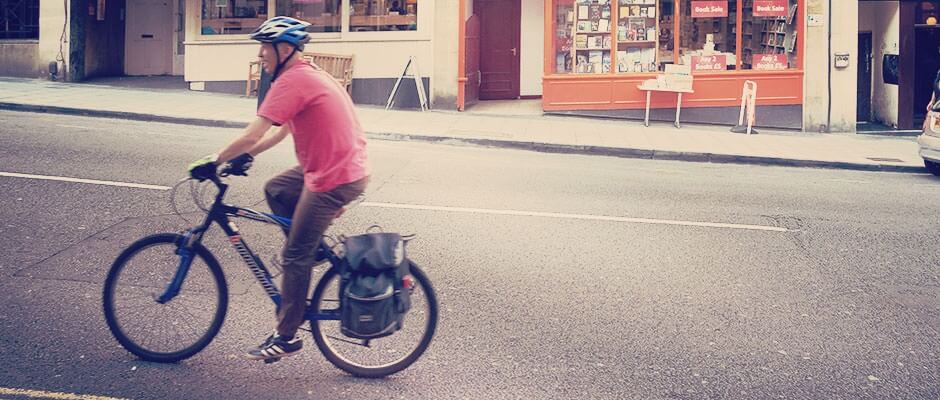As a driver, how would you like less traffic, less pollution, less competition for a parking space and fewer cars in front of you at the lights?
Add to that more green spaces, prosperous neighbourhoods and better health and it all begins to sound too good to be true doesn’t it?
But an increasing number of people believe we can achieve all this with the help of the bicycle. And that encouraging cycling doesn’t just help cyclists it can improve life for everyone. Even motorists!
The benefits of cycling for all road users
News from around the world increasingly suggests that cycling can be good for drivers and for society.
In Copenhagen, authorities have calculated that, taking into account health benefits, time saved and reduced congestion and car crashes, their society makes a net profit of around 13p (1.22 Danish kroner) for every kilometre cycled and a net loss of 8p for every kilometre driven by car.¹
To find out more about the benefits of City cycling have a look at this video, ‘Copenhagen Bike Paths – An Example To All Cities’.
Research in New York showed that cycle lanes in Manhattan led to a 35% decrease in injuries on 8th Avenue, a 58% decrease in injuries on 9th Avenue and a 49% increase in retail sales on 9th Avenue.²
Cycling improves air quality for everyone. In June 2012, a report for the Central London Air Quality Cluster group of local authorities found that if just 14 per cent of journeys in Central London were cycled, emissions of the greatest vehicle pollutant, NOx, would fall by 30 per cent (or 453 tonnes a year) and emissions of the other main vehicle pollutant, particulate matter, would fall by 24 per cent (33.8 tonnes a year). According to the Massachusetts Institute of Technology, air pollution from vehicles prematurely kills 2,200 Londoners every year, many of them in Central and Inner London.³
Are short journeys best by car or bike?
In the UK, over half of all journeys less than five miles are made by car. In fact, more than two thirds of all car journeys are of five miles or less,⁴ leading to traffic congestion and pollution.
However, if junctions and roads could be better designed and include safe cycle lanes and more secure cycle parking, then more people might be encouraged to use their bicycles for short distances and this would free up the roads for those who still want to use their car.
Easing pressure on public transport
Encouraging cycling can help reduce pressure on public transport. For example, the new London Cycle Superhighway planned for Victoria Embankment will carry 1,000 cyclists an hour which is the
equivalent of four Tube trains running along the District and Circle lines beneath. Andrew Gilligan, London’s new cycling commissioner, said: “For a comparatively extremely modest amount of money, we can unlock significant capacity on the Tube.”⁵
Safe bike lanes
If cycling can be made safe and inviting, similar benefits could be found across the country, freeing up public transport and bringing huge health benefits.
Interestingly, when safe bike lanes are implemented well, the results can be counter intuitive and far from causing gridlock they can make life better for the area and for motorists.⁶
Protected bike lanes in New York City have been shown to improve everyone’s safety⁷, increase retail sales for shops along the street⁸, and even speed up car traffic⁹.
For more information on the rise of protected bike lanes in the US take a look at this video.
A vision for the future
The financial, health and motoring benefits of cycling will become truly significant when enough people feel that cycling is for them – that it is safe, accessible and practical. This means investing in improved cycle provisions and building cycle lanes which are segregated from other traffic.
Key to this vision of the future is making the roads safe enough for cyclists and motorists to share.
Interested in finding out more?
Watch this video from the BBC of a cycle trip from The Netherlands to London exploring if the British can learn from the Dutch.
Sources
(1) http://www.thetimes.co.uk/tto/public/cyclesafety/article3590021.ece
(2) http://www.thetimes.co.uk/tto/public/cyclesafety/article3755751.ece
(3) http://www.london.gov.uk/sites/default/files/Cycling%20Vision%20GLA%20template%20FINAL.pdf
(4) http://www.thetimes.co.uk/tto/public/cyclesafety/article3755751.ece
(5) http://www.thetimes.co.uk/tto/public/cyclesafety/article3755751.ece
(6) http://www.wired.com/2014/11/9-things-drivers-need-stop-saying-bikes-vs-cars-debate/
(7) http://www.streetsblog.org/2014/09/05/new-dot-report-shows-protected-bike-lanes-improve-safety-for-everybody/
(8) http://www.streetsblog.org/2013/12/20/dot-bennett-midland-study-economic-impact-retail-sales-bike-lanes-plazas-sbs/
(9) http://www.fastcoexist.com/3035580/new-york-citys-protected-bike-lanes-have-actually-sped-up-its-car-traffic
